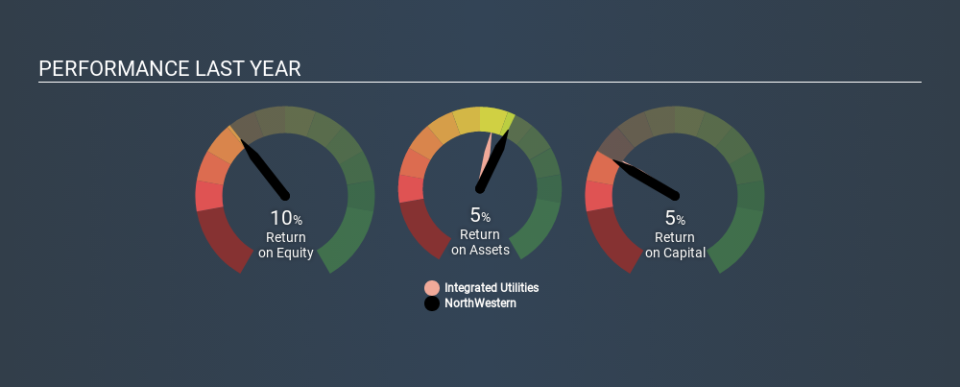What Does NorthWestern Corporation’s (NYSE:NWE) 4.8% ROCE Say About The Business?

Today we'll look at NorthWestern Corporation (NYSE:NWE) and reflect on its potential as an investment. In particular, we'll consider its Return On Capital Employed (ROCE), as that can give us insight into how profitably the company is able to employ capital in its business.
First up, we'll look at what ROCE is and how we calculate it. Then we'll compare its ROCE to similar companies. Finally, we'll look at how its current liabilities affect its ROCE.
What is Return On Capital Employed (ROCE)?
ROCE is a measure of a company's yearly pre-tax profit (its return), relative to the capital employed in the business. All else being equal, a better business will have a higher ROCE. In brief, it is a useful tool, but it is not without drawbacks. Author Edwin Whiting says to be careful when comparing the ROCE of different businesses, since 'No two businesses are exactly alike.
So, How Do We Calculate ROCE?
The formula for calculating the return on capital employed is:
Return on Capital Employed = Earnings Before Interest and Tax (EBIT) ÷ (Total Assets - Current Liabilities)
Or for NorthWestern:
0.048 = US$269m ÷ (US$5.9b - US$334m) (Based on the trailing twelve months to December 2019.)
Therefore, NorthWestern has an ROCE of 4.8%.
See our latest analysis for NorthWestern
Is NorthWestern's ROCE Good?
When making comparisons between similar businesses, investors may find ROCE useful. Using our data, NorthWestern's ROCE appears to be around the 5.0% average of the Integrated Utilities industry. Setting aside the industry comparison for now, NorthWestern's ROCE is mediocre in absolute terms, considering the risk of investing in stocks versus the safety of a bank account. Investors may wish to consider higher-performing investments.
You can see in the image below how NorthWestern's ROCE compares to its industry. Click to see more on past growth.
Remember that this metric is backwards looking - it shows what has happened in the past, and does not accurately predict the future. ROCE can be deceptive for cyclical businesses, as returns can look incredible in boom times, and terribly low in downturns. ROCE is only a point-in-time measure. Future performance is what matters, and you can see analyst predictions in our free report on analyst forecasts for the company.
How NorthWestern's Current Liabilities Impact Its ROCE
Current liabilities are short term bills and invoices that need to be paid in 12 months or less. Due to the way the ROCE equation works, having large bills due in the near term can make it look as though a company has less capital employed, and thus a higher ROCE than usual. To check the impact of this, we calculate if a company has high current liabilities relative to its total assets.
NorthWestern has current liabilities of US$334m and total assets of US$5.9b. Therefore its current liabilities are equivalent to approximately 5.7% of its total assets. NorthWestern reports few current liabilities, which have a negligible impact on its unremarkable ROCE.
What We Can Learn From NorthWestern's ROCE
NorthWestern looks like an ok business, but on this analysis it is not at the top of our buy list. Of course, you might also be able to find a better stock than NorthWestern. So you may wish to see this free collection of other companies that have grown earnings strongly.
If you like to buy stocks alongside management, then you might just love this free list of companies. (Hint: insiders have been buying them).
If you spot an error that warrants correction, please contact the editor at editorial-team@simplywallst.com. This article by Simply Wall St is general in nature. It does not constitute a recommendation to buy or sell any stock, and does not take account of your objectives, or your financial situation. Simply Wall St has no position in the stocks mentioned.
We aim to bring you long-term focused research analysis driven by fundamental data. Note that our analysis may not factor in the latest price-sensitive company announcements or qualitative material. Thank you for reading.

 Yahoo Finance
Yahoo Finance 
